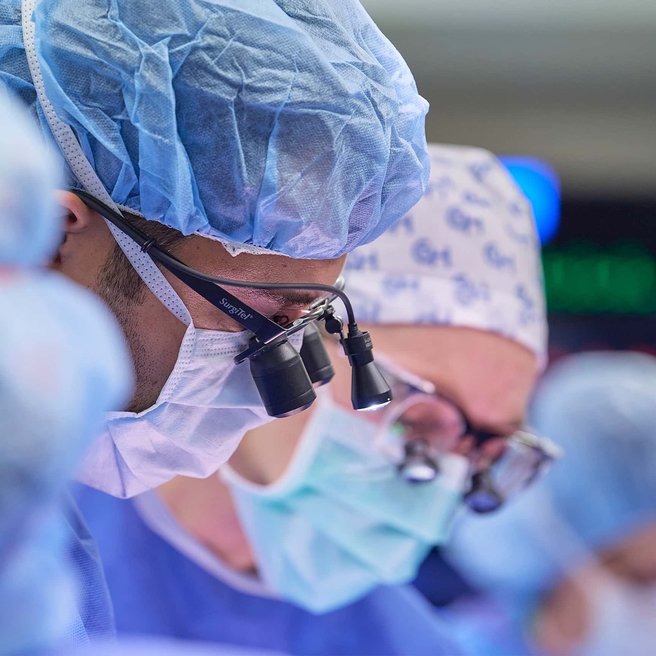What is Kniest dysplasia?
Kniest dysplasia is an extremely rare disorder of bone growth that leads to short stature, malformed bones and joints, and skeletal abnormalities. It's diagnosed only once out of every 1 million births.
A distinctive feature of Kniest dysplasia is hundreds of small holes in the bone cartilage, making it appear like Swiss cheese on an X-ray. The holes weaken the cartilage, which serves as connective tissue throughout the body, and causes joint stiffness and swelling.
Considered one of several forms of dwarfism, babies with Kniest dysplasia are born with a short trunk and shortened arms and legs. They may also have craniofacial anomalies such as flat faces, bulging eyes, a short neck and/or cleft palate. Limb deformities such as club foot are also common with Kniest dysplasia.
As they grow older, children with Kniest dysplasia often have medical issues that require treatment such as scoliosis, joint stiffness and hearing and vision problems.
Children with Kniest dysplasia have normal intelligence. The disorder was named in 1952 for Wilhelm Kniest, a German physician.
Causes
Kniest dysplasia is caused by a random genetic change. Usually sporadic, it is the result of a genetic defect of encoding type II collagen (COL2A1). Most Kniest mutations are due to slight genetic changes on chromosome 12.
Most cases of Kniest dysplasia result from new mutations of the gene and occur in families with no history of the disorder.
However, Kniest can be inherited; the condition follows an autosomal dominant pattern. That means if one parent has Kniest dysplasia, each of their children has a 50 percent chance of inheriting the disorder.
Signs and symptoms
Symptoms of Kniest dysplasia can include:
- Short limbs
- Shortened body trunk, making the child appear barrel-chested
- Scoliosis
- Hip dysplasia, in which the two hip joints are misaligned or crooked
- Swollen, stiff or deformed joints that prevent full movement (particularly knees and elbows)
- Brittle bone cartilage that is weakened by small holes making the cartilage look like Swiss cheese on X-rays
- Foot deformities, including clubfoot
- Round, flat face with bulging or wide-set eyes
- Cleft palate, an opening or gap in the roof of the mouth
- Hearing loss and vision problems
- Inguinal hernia, in which an internal organ bulges through an opening into the abdomen
- Respiratory issues
Testing and diagnosis
Diagnostic evaluation usually begins with a thorough medical history and physical examination of your child. At Children’s Hospital of Philadelphia (CHOP), clinical experts use a variety of diagnostic tests to diagnose Kniest dysplasia and possible complications, including:
- X-rays, which produce images of bones.
- Magnetic resonance imaging (MRI), which uses a combination of large magnets, radiofrequencies and a computer to produce detailed images of organs and structures within the body.
- Computed tomography (CT) scan, which uses a combination of X-rays and computer technology to produce cross-sectional images ("slices") of the body.
- Genetic testing, in which a sample of your child’s saliva or blood is used to identify your child’s DNA.
- EOS imaging, an imaging technology that creates 3-dimensional models from two planar images. Unlike a CT scan, EOS images are taken while the child is in an upright or standing position, enabling improved diagnosis due to weight-bearing positioning.
All of these medical tests allow clinicians to gather a full picture of your child’s medical health and help in determining an individualized care plan.
In some cases, Kniest dysplasia can be suspected or diagnosed when the child is still in its mother’s womb. Prenatal tests such as amniocentesis and CVS can identify the known Kniest mutations; a sonogram at the end of second trimester can identify some of the bone anomalies. For more information about prenatal testing for skeletal dysplasias, see the Center for Fetal Diagnosis and Treatment.
Treatments
Treatment for Kniest dysplasia is multi-pronged because the condition affects several body systems. In some cases, careful monitoring may be all that is required. In other cases, non-surgical or surgical treatments may be needed to address specific aspects of the condition.
At Children’s Hospital of Philadelphia, we practice collaborative, family-centered care. A team of expert clinicians — including leading surgeons and physicians, pediatric nurses, physical and occupational therapists, psychologists and other specialists — will partner with you in the care of your child.
Many children with Kniest dysplasia are also diagnosed with a variety of orthopedic conditions including: scoliosis, hip dysplasia, joint stiffness, craniofacial anomalies and limb shortening. In some cases, these conditions are present at birth and can be treated when the child is young.
For example, a child with a cleft palate or club foot will need surgery; while a child with slight hearing loss may only need to be monitored to ensure the condition doesn't worsen. Orthopedic specialists from our Hand and Arm Disorders Program, Leg and Foot Program and Audiology will work with your family to create an individualized care plan for your child.
In other cases, the complication from Kniest dysplasia may only become evident — or problematic — as your child grows. This is often true for spinal deformities such as scoliosis, hip conditions, knee complications and joint stiffness.
Depending on your child’s needs, orthopedic specialists from our Spine Program, our Hip Disorders Program and/or our Leg and Foot Program will treat your child.
Every child’s condition is different, so treatment is determined on a case-by-case basis. For example, if your child has scoliosis, our team of specialists will consider the severity of the curve, where it occurs in the spine, and your child's age and stage of growth, before determining the best course of action.
Treatment may include non-surgical options such as bracing and physical therapy, or surgical options such as spinal fusion or implanting growing rods to stabilize your child’s spine as he continues to grow.
Follow-up care
Your child with Kniest dysplasia should continue to be monitored by an orthopedic physician into adulthood.
If your child had spine surgery, he or she will need to see the orthopedic surgeon about one to two weeks after surgery, then again at three and six months post-surgery. After that, annual monitoring by trained clinicians is strongly encouraged to ensure any problems are spotted and treated as soon as possible.
Additionally, physicians may recommend your child see several different specialists because other body systems may be affected by Kniest dysplasia.
For example, your child may see:
- An orthopedist for any bone-, muscle- and joint-related issues
- A plastic surgeon for craniofacial or hand anomalies
- An audiologist for any hearing issues
- An ophthalmologist for vision problems
- Physical therapists and occupational therapists to expand your child’s physical dexterity and skill
During follow-up visits, X-rays and other diagnostic testing may be done. The goal of continued monitoring is to help spot any irregularities in growth or development and to address health issues as they develop.
Follow-up care and ongoing support and services are available at our Main Campus and throughout our CHOP Care Network. Our team is committed to partnering with you and referring physicians to provide the most current, comprehensive and specialized care possible for your child.
Outlook
Children with Kniest dysplasia can lead relatively normal lives. They have normal intelligence and a normal life span. They can hold good jobs, get married, have children and more.
Individuals with Kniest dysplasia may experience arthritis early because of joint abnormalities and may not be able to participate in certain activities.
If you have questions about how your child’s condition and any related health issues may affect your child’s prognosis or long-term goals, talk to your child’s healthcare provider.

Why choose CHOP
By sharing our surgical knowledge, clinical experience and innovative research, our program offers a depth and breadth of experience treating spine conditions that is unparalleled in the region.
Resources to help
Spine Program Resources
We have created video, audio and web resources to help you find answers to your questions and feel confident with the care you are providing your child.
